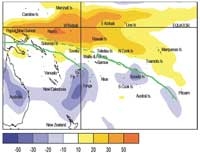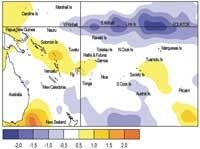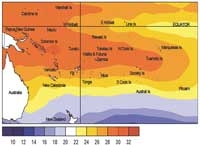Climate developments in December 2007

The South Pacific Convergence Zone (SPCZ) extended from the monsoon trough over Papua New Guinea, the Solomon Islands, and toward Fiji, displaced further south and west than normal for the time of year in that region. Another portion of the SPCZ extended from the region north of Samoa to the Society Islands and further southeast. A large region of very suppressed convection persisted along the equator, extending much further west than in November, affecting the region north of Papua New Guinea, Nauru, Kiribati, and the regions further east (both north and south of the Equator) including the Northern Cook Islands.
The South Pacific Convergence Zone (SPCZ) extended from the monsoon trough over Papua New Guinea, the Solomon Islands, and toward Fiji, displaced further south and west than normal for the time of year in that region. Another portion of the SPCZ extended from the region north of Samoa to the Society Islands and further southeast. A large region of very suppressed convection persisted along the equator, extending much further west than in November, affecting the region north of Papua New Guinea, Nauru, Kiribati, and the regions further east (both north and south of the Equator)including the Northern Cook Islands.
In contrast December rainfall was 25% or less of normal over much of Kiribati, and the parts of the Cook Islands.
Rainfall has been below average for each of the past 7 months in Kiribati, and above average for each of the past 4 months in Fiji.
December mean air temperatures were about 1.0 ºC below normal in the Southern Cook Islands and parts of southern French Polynesia, and 0.5ºC or more above normal in Western Kiribati, New Caledonia, and Tonga.
Tropical Southwest Pacific mean sea-level pressures were below average over New Caledonia and Papua New Guinea.Higher than normal pressures occurred southeast of New Zealand toward the region south of the Cook Islands, and over all of French Polynesia.
Equatorial surface easterlies remained persistent at Tarawa, occurring in almost all observations.
| Country | Location | Rainfall (mm) | % of average | Comments |
|---|---|---|---|---|
| Cook Islands | Penrhyn | 31 | 10 | Extremely low |
| Fiji | Nadi Airport | 335 | 188 | Well above normal |
| Fiji | Udu Point | 630 | 239 | Record high |
| New Zealand | Whangarei | 175 | 192 | Well above normal |
| Australia | Norfolk Island | 306 | 373 | Extremely high |
Soil moisture in December 2007

Estimates of soil moisture shown in the map (right) are based on monthly rainfall for one station in each country. Currently there are not many sites in the water balance model. It is planned to include more stations in the future.
The information displayed is based on a simple water balance technique to determine soil moisture levels. Addition of moisture to available water already in the soil comes from rainfall, and losses via evapotranspiration. Monthly rainfall and evapotranspiration are used to determine the soil moisture level and its changes.
Please note that these soil moisture calculations are made at the end of the month. For practical purposes, generalisations were made about the available water capacity of the soils at each site.
Soils continued to be moist (at field capacity) for the time of year at Nadi (Fiji), Hanan Airport (Niue), and Rarotonga (Cook Islands).
El Niño/Southern Oscillation (ENSO)


During December La Niña conditions strengthened into a moderate – strong event. La Niña conditions spread into the western tropical Pacific. The Southern Oscillation Index (SOI) continued its strong movement upwards, indicating a further strengthening of the ocean-atmosphere coupling.
Below normal sea surface temperature (SST) anomalies stabilised across the tropical Pacific from South America to west of the Date Line during December, while a warm “horseshoe” continues in the extratropics of both hemispheres. The NINO3 anomaly was –1.3 °C for December (OND average –1.4 °C), while NINO4 strengthened to –0.9 °C (OND average –0.7 °C). The subsurface temperature anomalies have strengthened again: the largest anomalies near 100m depth over 120-100°W during December were about -4 °C (-2 °C in November).
The easterly trade winds were also strong and persistent during December over a wide longitude band, and spread west of the Date Line. The SOI was +1.4 for December (+1.1 November), with the OND average of +1.0.
Tropical OLR anomalies show suppressed convection in the equatorial region from west of the Date Line (140 °E) eastwards. Enhanced convection occurred over Indonesia and parts of northern Australia, and the South Pacific Convergence Zone is prominent between New Caledonia and Tonga. The TRMM-based ENSO precipitation index was –1.35 in December, well into the moderate range. The Madden-Julian Oscillation has displayed a fairly regular periodicity of 40-50 days in recent months, and the current active phase has initiated monsoon development over northern Australia, which should spread into the Pacific in early January, then dissipate.
All models now clearly indicate La Niña conditions. Most models indicate La Niña conditions continuing through the southern summer and autumn, before easing to neutral conditions in winter 2008. The NCEP synopsis (of 6 December) indicates La Niña has reached moderate strength (Niño3.4 index below -1.0°C), and likely to continue into the austral autumn. The IRI synthesis shows that moderately strong La Niña conditions exist presently, with more than a 97% probability of La Niña conditions through the next three months.
Forecast validation: October to December 2007
A La Niña-like pattern, with a large region of enhanced convection and above average rainfall, was expected from the Solomon Islands southeast to Niue, including Vanuatu, New Caledonia, Fiji, Tonga, and Samoa, with average or above average rainfall in Papua New Guinea, the Southern Cook Islands, and the Society and Austral Islands. Suppressed convection with below average rainfall was expected over Kiribati, with average or below average rainfall in Tuvalu, Tokelau, and the Northern Cook Islands. Rainfall was lower than expected in the Marquesas Islands.
The rainfall outlook for the October – December 2007 period was very similar to what was forecast, the ‘hit’ rate being 77%.
